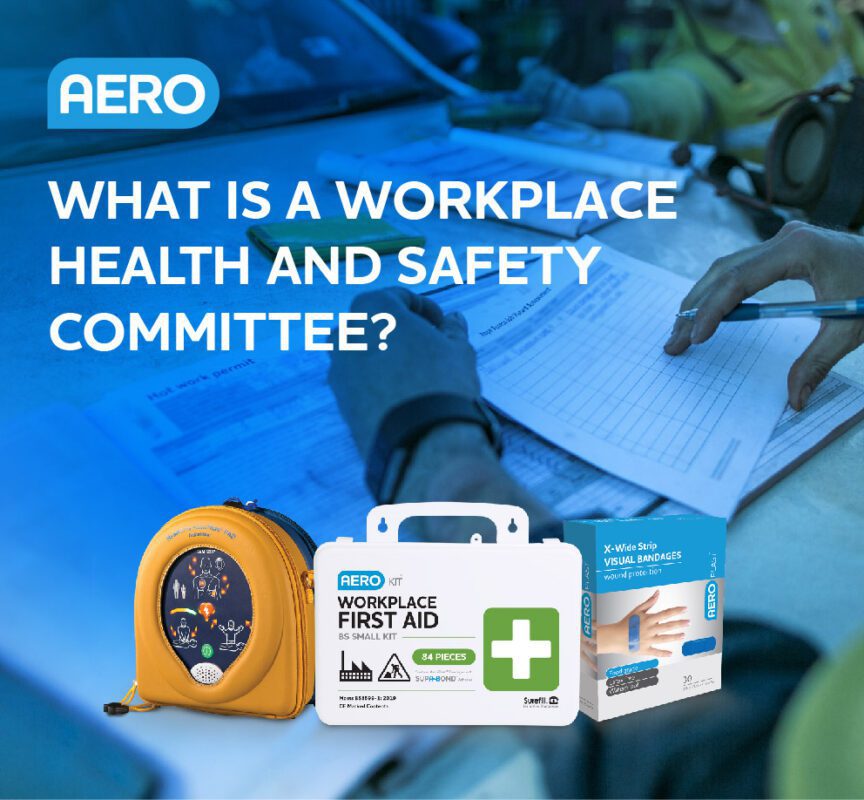Blog
What is a workplace health and safety committee?
Published 05/06/2023
Health and safety is often a term that’s banded around the workplace, but its relevance and importance is vital for workers and businesses alike.

Do your employees know where your HSE-required first aid kit is in the office? Approximately 83% wouldn’t be able to locate it in their own office. These are some of the vital points that workplace health and safety committees look at.
Workplace health and safety committees are made up of hard-working individuals across various departments within a business. As well as providing a safety-conscious attitude, these individuals ensure potential risks are assessed and analysed. Their understanding and experience often prove invaluable for risk assessments, especially as representatives are exposed to the same hazards they report on.
In fact, good health and safety can improve morale and reduce sickness. With positive results, organisations are taking conscious decisions to implement workplace health and safety committees. It’s true that some industries are considered more high-risk than others. That’s why a committee, made up using key members within different departments, is the best solution. But, what can this do for an organisation and what solutions are available?
What is a workplace health and safety committee?
In its simplest form, a workplace health and safety committee assesses risks and hazards that need to be managed, alongside solutions that ensure the well-being of staff, visitors and, in some cases, the public. It is a legal requirementfor employers to protect workers and others from getting hurt or ill through their work. Failure to do so could result in lengthy and expensive claims from employees as well as possible convictions. That’s why health and safety committees are so important, they ensure risks are covered and addressed before they can occur.
As a collective group, the workplace health and safety committee will establish and address all risks, providing a plan and detailed assessment. It’s worth noting that work-based injuries are not the only considerations that committeesmust make. During meetings, they are able to address:
- statistics around accident records, ill health and absences
- workplace inspections by authorities, management or health and safety representatives
- workplace changes that affect health and safety
- workplace changes that have the potential to impact mental health and welfare
- investigation into accidents and subsequent action to be taken
- workplace risk assessments
- employee-related risk assessments
- health and safety training
- emergency procedures and plans
- adequate first aid provision and management
Why do workplaces need a health and safety committee?
Every workplace has its risks, and they don’t just vary from industry to industry. Where colleagues may have health or mobility issues, a health and safety committee can be successful in ensuring individuals are fully supported.
As health and safety requirements are anything but linear, the UK government has basic guidelines that must be followed by all employers. For some industries, there is a greater onus on health and safety representatives to accurately identify specific workplace risks. This can typically be found in higher-risk industries, such as logistics, haulage and construction-based roles. Workers in these professions can suffer non-fatal injuries originating from slips, trips and falls (26%), as well as manual handling-related problems (18%), and falls from height (19%). After all, it seems a little nonsensical to attribute these same risks to an office job.
There’s no legal requirement for any workplace to hold a health and safety committee, especially when employees don’t belong to a trade union. However, it is good practice to have one. For many businesses, it’s better to prepare a committee ahead of time. If more than two union-appointed health and safety representatives provide a written request for a committee, this must be completed within three months.
Where certain industries carry greater risk, especially those in construction and industrial roles, appointing a health and safety committee ensures that all voices are heard when it comes to workplace requirements. Likewise, pre-empting possible problems and tackling them before they arise ensures greater continuity for employers as well as employees.
Do office workers and those in lower-risk professions require less when it comes to health and safety? Absolutely not – it’s still a legal requirement for employers to ensure the protection of their employees whilst at work. It just might be the case that some choose to do more, going above the duty of care required by the UK government. As such, employers could decide to introduce increased break times throughout the day to maximise well-being or install a defibrillator for enhanced first aid at work.
What companies should have a health and safety committee?
Workplace health and safety committees offer a structured approach to consultation between bosses, management and employees, but it is not a legal requirement for companies to have this unless it is requested by union-appointed representatives. It is highly advised that organisations adopt this process into their way of working to improve unknown health and safety issues and provide transparency in decision-making.
Every company will benefit from having elected health and safety representatives, especially as they are able to capture the concerns and voices of the wider business. They often bridge the gap in communication between management and employees. Likewise, a committee offers a level of futureproofing and accountability for a business that might otherwise be destroyed by a health and safety complaint in the workplace. For example, corporations that ignore – what might seem minor – slip hazards after they are reported are liable for an employee or visitor if they are injured on site. This could result in conviction, fines and a damaged brand reputation.
What are the responsibilities of a health and safety committee representative?
Assess new hazards with utmost priority
At any time, a new hazard or risk can arise; this could be due to a change in materials, equipment, or employee well-being. Proactive organisations should jump on risks by immediately assessing them and establishing any next step.
Monitor hazards and how they evolve
After a risk assessment is complete, and the hazard is made known, representatives must track and manage these. Through a range of variables, hazards are likely to evolve and will need to be addressed for health and safety purposes.
Review risks and their impact on employees
Many businesses look at other external factors that might affect their employees to establish their risks. For example, more industrial-based professions have highlighted a need for defibrillator solutions within their workplaces to support male-dominated industries, especially as men are two to three times more likely to experience sudden cardiac arrest. Additionally, repetitive strain injuries are also common across many industries, which can have an impact on an employee’s livelihood. The committee will address this to find ways around supporting employees further.
Recommend appropriate action for change
Where new risks are identified, a clear log of action should be documented in response. These should appropriately affect the type of risk, individuals impacted and any other variables that could be impacted.
Act as a voice for those within the department
Perhaps the most important role of a health and safety representative is to accurately document and share any risks or concerns affecting others within their department. For those unable to access meetings, this accurately conveys genuine issues and problems experienced by workers. As committee members are made up of various personnel across a range of departments and these representatives ensure all concerns from different areas of the business are reflected.
Offer impartiality with facts, statistics and workplace incidents
Almost like a jury, a committee relies on a level of impartiality to accurately define possible causes for risks. Likewise, any incidents that have occurred need to be reviewed without bias towards either the employee or employer.
What is good practice for a workplace health and safety committee?
Adequate first aid provisions
It’s already legislation that employers must supply adequate first aid provisions for the safety of workers, site visitors and others that have access. Sourcing the correct first aid supplies, without the hassle of purchasing unnecessary consumables, can be a tiresome and difficult task. That’s why utilising first aid suppliers is the best option for workplace health and safety committees. Not only does it guarantee first aid consumables that are fit for purpose, but it allows a consolidated approach that is easy to manage.
Continuously up-to-date risk assessments
Keeping risk assessments updated is vital whether you’re a business with remote workers or manage professionals on an active building site.. Any potential issues that are left without evaluation or appropriate review could make employers liable for complaints and possible convictions. Utilising a workplace health and safety committee means active and potential risks continue to be monitored, addressed and evaluated.
Evaluate staff behaviour with impartiality
Using software that measures employee well-being is an excellent way to ensure your staff are able to perform at their best. Reducing sickness absences and workplace injuries can be attributed to above-average health and safety legislation. Not only can this mean less time off work for employees, but it can enhance productivity significantly. British Sugar noted a two-thirds reduction in time lost and frequency of minor injuries over a 10-year period.
How Aero Healthcare works with workplace health and safety committees
Our consolidated solutions offer workplace health and safety committees a simplified approach to procuring first aid. Based on risk assessments and industry-specific requirements, our account managers carefully tailor first aid requirements using our Aero-branded range. With refill schemes also available, we find our customers are more at ease when adhering to first aid regulations for the workplace.
In the UK, workplace health and safety are regulated by the Health and Safety Executive (HSE). According to HSE statistics, in 2020/21, there were:
- 142 fatal injuries to workers
- 693,000 non-fatal injuries to workers
- 38.8 million working days lost due to work-related illness and workplace injury
These statistics highlight the importance of workplace health and safety in the UK. By implementing measures to prevent accidents, injuries, and illnesses, employers can not only protect their employees but also reduce the financial costs associated with lost productivity and absenteeism.
Moreover, promoting a safe working environment can also improve employee morale and job satisfaction, leading to increased productivity and decreased turnover rates. Therefore, investing in workplace health and safety is not only a legal requirement but also a smart business decision.
Aero Healthcare boasts a team of seasoned advisors who possess the necessary expertise to suggest tailored health and safety solutions that cater to your organisation’s requirements. Don’t hesitate to contact us directly to book a consultation.
Have first aid requirements that need to match specific health and safety criteria?
At Aero Healthcare we are proud to offer a range of first aid consumables, kits and defibrillator solutions that ensure duty of care within your workplace. Our account managers work with you to understand your exact needs. If you manage multiple worksites that carry varying risks, we can support too. We’ll provide you with a consolidated approach when it comes to managing your first aid requirements. Ask us how, today!
Share this article

